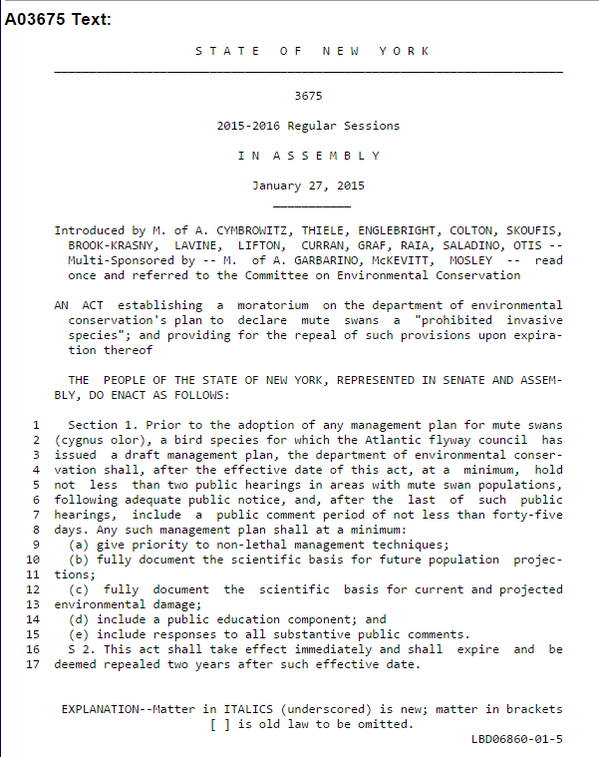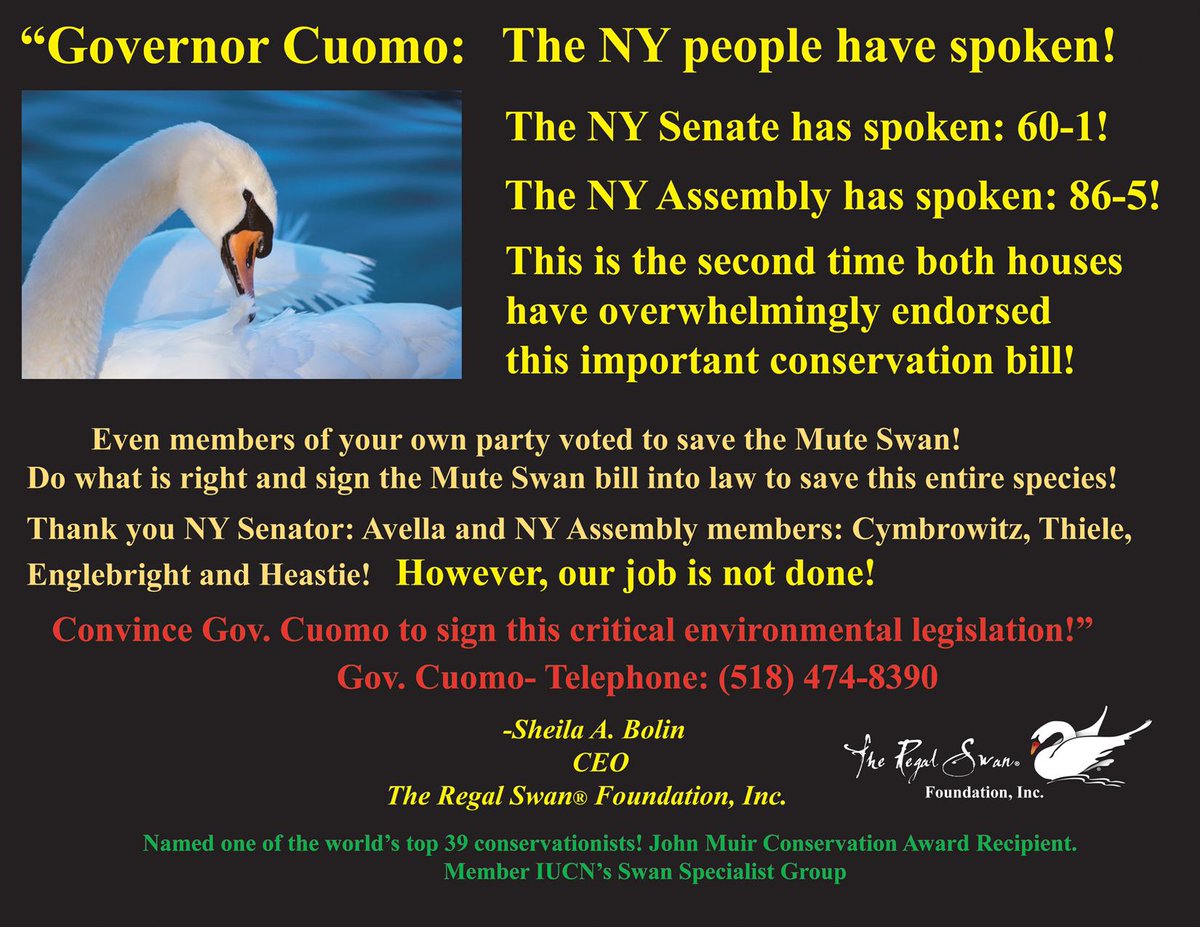A Letter from Sheila A. Bolin,
CEO/President, The Regal Swan® Foundation, Inc.
***
Sheila Bolin is the CEO/President and co/founder of The Regal Swan® Foundation, Inc., based in Orlando, Florida. The RSF’s mission is providing humane treatment and veterinary care for swans worldwide through research, education, veterinary care, conservation and swan product development. Bolin serves on the RSF’s education/research/veterinary team, has co-authored two swan care and habitat related books, conducted numerous swan education workshops, co-published veterinary care and habitat related articles for numerous journals and magazines and has appeared on television, radio and other media for her work with swans. Since 2005, she has served as Ask The Swan Specialist for the Vancouver, British Columbia Canada website: (www.stanley-park-swans.com)
Bolin has been named one of the top 39 conservationists in the world by the prestigious Indianapolis Prize for her work with the world’s species of swans. In 2014, Bolin spoke at the International Swan Symposium held in Easton, Maryland, February 3-6. This Symposium hosted some of the world’s leading swan experts.
In 2013, the Regal Swan Foundation, Inc., was named the recipient of the prestigious international John Muir Non-Profit for Conservation Award for their research work with swans.
In 2010, Bolin was nominated as “Scientist of The Month,” by the International Union for the Conservation of Nature, IUCN, based in Gland, Switzerland, for her swan research work. Bolin also serves as a member of the Swan Specialists Group.
***
Kill or Mutilate Wild Mute Swans
April 14, 2015
The NY DEC’s revised Mute Swan Management Plan is
the most barbaric and inhumane program ever proposed under the guise of
conservation. Here is what the “new
plan” proposes:
1. Kills all but 800 Mute Swans in New York, primarily in upstate NY near Rochester, Syracuse, etc.
2. Mutilates 800 Mute Swans by having their flight portion of their wing cut-of/amputated so they cannot fly. The NY DEC states that this procedure will be determined and conducted by a licensed veterinarian.
1. Kills all but 800 Mute Swans in New York, primarily in upstate NY near Rochester, Syracuse, etc.
2. Mutilates 800 Mute Swans by having their flight portion of their wing cut-of/amputated so they cannot fly. The NY DEC states that this procedure will be determined and conducted by a licensed veterinarian.
This
plan is exactly that, mutilation. Many will allude to a “clipping”. A clipping
is where the flight feathers are clipped and the bird will regrow the feathers
in approximately 6 months. This is not a
permanent solution to keep the birds from flying and is not the procedure that
the NY DEC will be using.
The
NY DEC’s plan demands the amputation of the flight part of the wings to
include, bones, tendons and muscles will be amputated/cut-off, thus maiming the
swan forever and not allowing them to fly. Pinioning is used in captive settings because
the procedure is completed at 1-3 weeks of age and does not require
anesthesia. It is not acceptable in the
wild setting especially for so many swans. Will the NY DEC conduct this
mutilation without anesthesia or pain management which is required due to the
procedure being difficult on older or flying birds? Some swans will not make it
off the table. Yet, this will be another way to legitimately kill the swans
under the NY DEC’s plan.
Once
a portion of the swans’ wings are
amputated, the NY DEC will then place the swans in a captive setting so the
only place you will ever see a Mute Swan is in a zoo, park or someone’s back
yard, unless the swans find their way to a canned hunting farm.
Mutilation
is defined as the crippling, maiming, or mangling to cause such a severe injury
as to cause lasting damage and destruction of something beautiful. The killing
and mutilation of these beautiful birds is reprehensible, especially, since
they are the “International Symbol of World Peace!” The NY DEC states that this procedure will be
conducted under the supervision of a licensed veterinarian. We wonder if the NY
Veterinary Medical Association, American Veterinary Medical Association or any
licensed veterinarian who has sworn to “do no harm” would agree and participate
in this unnecessary medical procedure to maim 800 healthy wild swans by the NY
DEC.
What’s even more amazing is that two of the largest
purported bird conservation groups in North America back this
killing/mutilation program. According to the NY DEC, Audubon Society and
Cornell University are supporting this Mute Swan management plan. Imagine that, considering the Audubon Society
has stated that this is the biggest fundraising time of the year for them and
would like you to donate for their bird conservation efforts.
There is something that the DEC DOES NOT want you to
know. There is a third plan. Instead of killing and mutilating these beautiful
birds, the NY DEC can leave the Mute Swans alone as they are not an invasive
species, rather an indicator/sentinel species that alert us to problems in the environment. The NY DEC should have read their own report because they stated
this fact in their plan. Furthermore, the NY DEC never conducted an
Environmental Impact Study prior to proposing this plan. The NY DEC should be
required to conduct such a study before touching one feather on a Mute
Swan. The NY DEC’s research is outdated,
incomplete, used misquoted references and is completely disputed by new
research by some of the foremost wetland habitat and swan specialists in the
world.
The NY DEC’s own proposal shows that its purported
research was never completed due to the NY DEC destroying the research by
either removing or shooting the test subjects. What scientific research project
shoots or removes the test subjects?
But, this is how the NY DEC conducted their so-called research. The
Atlantic Flyway Council, of which the NY DEC is a member, had members state
last year that NO collaborative systemic count of the Mute Swans has ever been
conducted in the U.S. Researchers also
note that there has NEVER been an Environmental Impact Study on the Mute Swans
in the U.S. Therefore, how can the NY
DEC state that they know how many swans are in NY and their impact on the
environment without such a study. They can’t! Unfortunately, they believe that
they are above the law, can commit cruelty against these beautiful birds and
dictate to a licensed veterinarian that the choice is to kill or mutilate.
You can stop this plan in its tracks.
Tell the DEC you will not be part of this
killing and mutilation program and they must conduct an environmental impact
assessment before harming another swan.
Comments on the revised draft mute swan plan may be
submitted in writing through April 24, 2015 to NYSDEC Bureau of Wildlife, Swan
Management Plan, 625 Broadway, Albany, NY 12233-4754 or by email to wildlife@dec.ny.gov
Please write and please sign this Petition. YOU can
stop this despicable plan.
Sheila A. Bolin, CEO/President, The Regal Swan®
Foundation, Inc.
http://www.theregalswan.com/home.html
http://www.theregalswan.com/home.html
RELATED VIDEOS :





